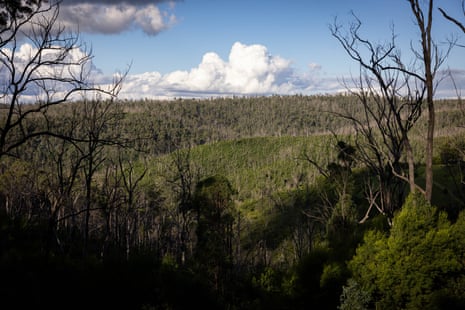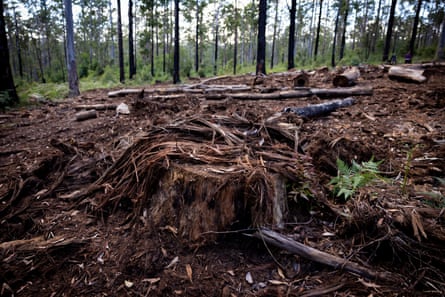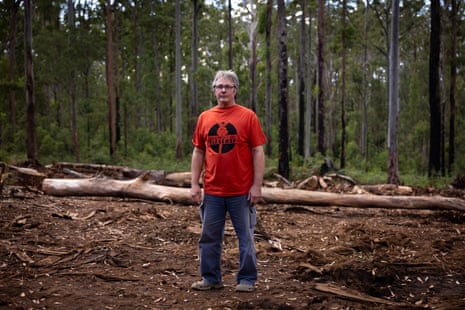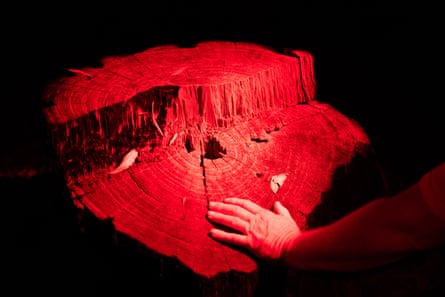After 25 years, logging and bushfires, a greater glider has been spotted in Deongwar state forest
It’s just after 8pm when Jess Lovegrove-Walsh, walking down a pitch-black fire trail through bushland about 100km west of Brisbane, trains her spotlight on a pair of laser-red eyes deep in the canopy.
“That’s a big long tail, it’s either a possum or a glider,” she yells, as a fellow ecologist from the Wildlife Preservation Society of Queensland, Paul Revie, runs ahead with his camera.
“Is it this tree?” he asks from 100 metres down the track, shining a red spotlight into the canopy. “No, deeper, a little further to the left,” Lovegrove-Walsh says. “OK, got him,” Revie replies. “It’s a greater!”

They have spotted Australia’s largest flying marsupial: the endangered greater glider. “They are these big graceful things that use their tails like a rudder, dropping mid-flight right before they hit a tree,” Lovegrove-Walsh says.
Equipped with a “gliding membrane” – a loose fold of skin joining their elbows and ankles – the possum-like animal, spanning more than a metre head to tail, spends most nights gliding between trees eating gum leaves.
The last confirmed sighting here, in the Deongwar state forest on the lands of the Dungibara people, was in the late 1990s. “It’s awesome to get confirmation that they are still here after the logging and fires,” Revie says.
Deongwar state forest contains 4,700 hectares of intact remnant native bushland and is a key wildlife corridor, connecting large tracts of nearby forest. But it’s missing a “key attribute” for greater glider habitat, Revie says: “Large old trees in good numbers – logging has taken all of those out.”
But in March the logging stopped. It was the long-planned outcome of an agreement struck in 1999 between the government, the timber industry and conservation groups. The south-east Queensland forest agreement stated that selective native timber harvesting, permitted in about 70,000 hectares of state forest in the south-east Queensland regional planning area, including Deongwar state forest, would cease at the end of 2024 “by the latest”.

It will take more than a century for the glider habitat to be restored.
“These animals need trees at least 150 years old; when you log a forest you change it in pretty dramatic ways,” says Prof David Lindenmayer from the Australian National University.
-
Sign up to receive Guardian Australia’s fortnightly Rural Network email newsletter
Extensive selective logging removes a large proportion of mature, hollow-bearing trees that dozens of species rely on for survival. Their absence also alters the forest’s microclimate, increasing ambient temperatures and the risk of fire, Lindenmayer says. “That’s bad news for greater gliders because they are very heat-sensitive animals,” he says.

In the 90s greater gliders were common along Australia’s eastern seaboard. Habitat fragmentation and encroachment by urban sprawl, the felling of mature hollow-bearing trees and global heating have caused their population to decline rapidly.
They were listed as vulnerable in 2016 and endangered in 2022 after the 2019-20 bushfires, which burned up to 70% of their remaining habitat.
“We probably lost about 50% of their population in 12 months,” Revie says.
Permanent protection still pending
The Deongwar state forest has been recognised as potential greater glider habitat. That’s the impetus behind a campaign to permanently protect the forest, led by the retired landscaper Max Fulham.
Fulham visited logging sites in Deongwar when driving through the area on his way to and from his home on the Sunshine Coast. “They’d cut out trees that were 110cm in diameter, I just thought, you can’t walk past that,” he says.
after newsletter promotion

In 2022 Fulham became involved in a successful community campaign against proposed logging in Beerwah state forest. He then started his own campaign to save Deongwar.
As part of the 25-year-old forestry agreement, the Queensland government committed to transferring up to a quarter of all state forests in the region (about 20,000 hectares) to conservation areas by the end of 2024. A spokesperson from the Queensland environment department says 2,550 hectares have already been transferred and the handover of an additional 12,000 hectares will “soon begin”.
Fulham wants this transfer to include Deongwar state forest to guarantee its permanent protection and effective management.
The department spokesperson told Guardian Australia the government was “progressing further additions to the conservation estate … including consideration of Deongwar state forest”.
The Queensland Conservation Council is advocating for the permanent protection of all 70,000 hectares of state forest in south-east Queensland.
A Dungibara traditional owner, Peta May, says the logging of state forests such as Deongwar will “leave a scar on the landscape for ever”.
“We now have the chance to move forward and begin the healing process in these protected areas,” she says.
Under the light of torches and red spotlights in Deongwar, Revie and Lovegrove-Walsh are still riding the high of spotting the greater glider, which they say means there are mature tree hollows in the area. “The greater speaks for many of our animals,” Revie says.

But their density in the area – or rather lack of it – also speaks volumes.
Walking the same distance in Nerang national park, a stronghold for the species, Lovegrove-Walsh would have seen at least half a dozen in the canopy. On Saturday night at Deongwar, they spotted one.
“What if there’s only a handful left in this forest?” she says. “There’s only a few hollows here, so that’s a real possibility.
“These species are a key indicator of the [health of] ecosystems which we also depend on for life … for clean water and air,” she says. “It’s the canary in the coalmine.”
-
Sign up for the Rural Network email newsletter
-
Join the Rural Network group on Facebook to be part of the community
Source: theguardian.com
